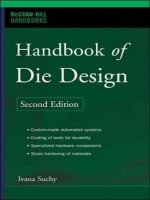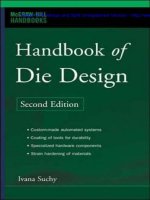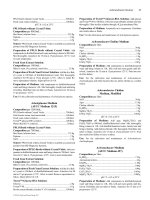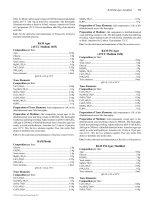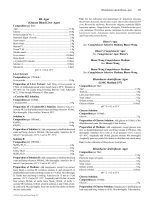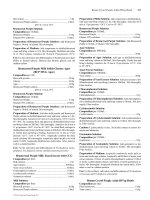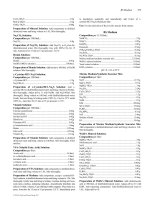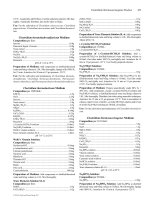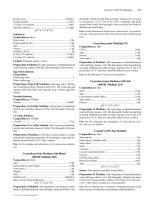handbook of die design 2nd edition phần 1 ppsx
Bạn đang xem bản rút gọn của tài liệu. Xem và tải ngay bản đầy đủ của tài liệu tại đây (1.26 MB, 72 trang )
http://72.3.142.35/mghdxreader/jsp/FinalDisplay.jsp;jsessionid=aag1B0
1 of 1 11/1/2007 8:46 AM
Catalo
g
in
g
-in-Publication Data is on file with the Librar
y
of Con
g
ress
Copyright © 2006, 1998 by Ivana Suchy.
All rights reserved. Printed in the United States of America. Except as permitted under the United States
Copyright Act of 1976, no part of this publication may be reproduced or distributed in any form or by any
means, or stored in a data base or retrieval system, without the prior written permission of the publisher.
1 2 3 4 5 6 7 8 9 0 DOC/DOC 0 1 0 9 8 7 6 5
ISBN 0-07-146271-6
The sponsoring editor for this book was Larry S. Hager and the production supervisor was Richard C.
R
uzycka. It was set in Times Roman by International Typesetting and Composition. The art director for the
cover was Handel Low.
P
rinted and bound by RR Donnelley.
This book is printed on recycled, acid-free paper containing a minimum of 50% recycled, de-inked fiber.
McGraw-Hill books are available at special quantity discounts to use as premiums and sales promotions, or
for use in corporate training programs. For more information, please write to the Director of Special Sales,
McGraw-Hill Professional, Two Penn Plaza, New York, NY 10121-2298. Or contact your local bookstore.
Information contained in this work has been obtained by The McGraw-Hill Companies, Inc. (“McGraw-Hill”)
from sources believed to be reliable. However, neither McGraw-Hill nor its authors guarantee the accuracy or
completeness of any information published herein and neither McGraw-Hill nor its authors shall be
responsible for any errors, omissions, or damages arising out of use of this information. This work is
published with the understanding that McGraw-Hill and its authors are supplying information but are not
attempting to render engineering or other professional services. If such services are required, the assistance o
f
an appropriate professional should be sought.
Copyright © 2006, 1998 by Ivana Suchy., McGraw-Hill
BASIC DIE DESIGN AND
DIE-WORK INFLUENCING
FACTORS
1-1 SHEET-METAL STAMPING IN COMPARISON
WITH OTHER METAL FABRICATING PROCESSES
In today’s practical and cost-conscious world, sheet-metal parts have already replaced
many expensive cast, forged, and machined products.
The reason is obviously the relative cheapness of stamped, or otherwise mass-produced
parts, as well as greater control of their technical and aesthetic parameters. That the world
slowly turned away from heavy, ornate, and complicated shapes, and replaced them with
functional, simple, and logical forms only enhanced this tendency. Remember old bath-
tubs? They used to be cast and had ornamental legs. Today they are mostly made of coated
sheet metal, if not plastics. Manufacturing methods for picture frames, chandeliers, door
and wall hardware, kitchen sinks, pots and pans, window frames, and doors were gradually
replaced by more practical and less costly techniques.
But, sheet-metal stampings can also be used to imitate handmade ornamental designs of
previous centuries. Such three-dimensional decorations can be stamped in a fraction of time
the repoussé artist of yesterday needed.
Metal extrusions, stampings, and forgings, frequently quite complex and elaborate,
are used to replace handmade architectural elements. Metal tubing, metal spun products,
formings, and drawn parts are often but cheaper substitutes of other, more expensive
merchandise.
Metal stampings, probably the most versatile products of modern technology, are used
to replace parts previously welded together from several components. A well-designed
sheet-metal stamping can sometimes eliminate the need for riveting or other fastening
processes (Fig. 1-1). Stampings can be used to improve existing designs that often are
costly and labor-intensive. Even products already improved upon, with their production
expenses cut to the bone, can often be further improved, further innovated, further decreased
in cost.
The metal stamping die (Fig. 1-2) is an ideal tool that can produce large quantities of
parts that are consistent in appearance, quality, and dimensional accuracy. It is a press tool
capable of cutting the metal, bending it, drawing its shape into considerable depths,
embossing, coining, finishing the edges, curling, and otherwise altering the shape and the
outline of the metal part to suit the wildest imaginable design concepts. Figure 1-3 shows
samples of these products.
CHAPTER 1
1
Suchy_CH01.qxd 11/08/05 10:28 AM Page 1
Downloaded from Digital Engineering Library @ McGraw-Hill (www.digitalengineeringlibrary.com)
Copyright © 2004 The McGraw-Hill Companies. All rights reserved.
Any use is subject to the Terms of Use as given at the website.
Source: HANDBOOK OF DIE DESIGN
The word “die” in itself means the complete press tool in its entirety, with all the punches,
die buttons, ejectors, strippers, pads, and blocks, simply with all its components assembled
together.
When commenting on these little technical ingenuities, it is important to stress the role
of designers of such products, both artistic and technical. Their thorough knowledge of the
manufacturing field will definitely enhance not only the appearance, but the functionality,
overall manufacturability, and cost of these parts.
2 CHAPTER ONE
FIGURE 1-1 Threaded part, replaced by other, less expensive means.
FIGURE 1-2 Metal stamping dies.
Suchy_CH01.qxd 11/08/05 10:28 AM Page 2
Downloaded from Digital Engineering Library @ McGraw-Hill (www.digitalengineeringlibrary.com)
Copyright © 2004 The McGraw-Hill Companies. All rights reserved.
Any use is subject to the Terms of Use as given at the website.
BASIC DIE DESIGN AND DIE-WORK INFLUENCING FACTORS
BASIC DIE DESIGN AND DIE-WORK INFLUENCING FACTORS 3
Metal stamping die production output can be enormous, with huge quantities of high-
quality merchandise, as shown in Figs. 1-3 and 1-4; pouring forth from the press. For that
reason technical ignorance is not readily excusable, as the equal quantities of rejects can be
generated just the same way.
1-1-1 Grain of Material
Often, parts produced by various manufacturing methods can be redesigned to suit the
sheet-metal mass production (Fig. 1-5).
FIGURE 1-3 Various sheet-metal products.
FIGURE 1-4 Metal-stamped replacements.
Suchy_CH01.qxd 11/08/05 10:28 AM Page 3
Downloaded from Digital Engineering Library @ McGraw-Hill (www.digitalengineeringlibrary.com)
Copyright © 2004 The McGraw-Hill Companies. All rights reserved.
Any use is subject to the Terms of Use as given at the website.
BASIC DIE DESIGN AND DIE-WORK INFLUENCING FACTORS
When designing such replacements, there are several aspects to be evaluated. The first
and probably the most important is the grain of material (Fig. 1-6).
Sheet metal of every form, be it a strip or a sheet, displays a definite grain line. It is the
direction along which the material was produced in the mill-rolling process. In coils, the
grain direction always runs lengthwise, parallel with the longer edge. The grain direction
4 CHAPTER ONE
FIGURE 1-5 Additional sheet-metal replacements.
FIGURE 1-6 Grain of materal in sheet-metal strip.
Suchy_CH01.qxd 11/08/05 10:28 AM Page 4
Downloaded from Digital Engineering Library @ McGraw-Hill (www.digitalengineeringlibrary.com)
Copyright © 2004 The McGraw-Hill Companies. All rights reserved.
Any use is subject to the Terms of Use as given at the website.
BASIC DIE DESIGN AND DIE-WORK INFLUENCING FACTORS
in sheets may vary, and designers must always make themselves familiar with it prior to
planning a production run of any kind.
In contrast, cast or forged parts display a different grain direction, and in sintered pow-
der metal parts the grain is completely gone. For this reason, each of these manufacturing
methods can be used to produce items for different applications.
For example, a part, shown in Fig. 1-7, will display a different reaction to various forces
and stresses when made by the forging method than when obtained through other manu-
facturing processes.
Where the forging would possess a great resistance to tensile and compressive forces
along the A-A line, the same part, when made from sintered powder metal, may break or
collapse under the same force.
With this shape being cast, the location of the gate is of extreme importance, as it influ-
ences the part’s sturdiness in various directions. In the casting gated at the longer end (as
pictured in Fig. 1-7b), the opposite end will be more susceptible to breakage, as the molten
metal will reach that portion later, when already cooling down. The existence of an open-
ing in that area will divide the flow of material and thus create a so-called knit line, along
which a separation, resulting in defects and possible breakage, may occur.
The same casting, when gated in the middle (Fig. 1-7c), will have an equal breakage
proneness at both ends. However, these ends will be somewhat sturdier, as the molten metal
will reach them sooner than in the case of Fig. 1-7b. Of course, the existence of openings
may have the same detrimental effect described earlier.
A similar product, made of sheet metal, as pictured in Fig. 1-8, will also display a grain-
dependent behavior; the part with the lengthwise grain will be considerably sturdier along
the A-A line of force than the same shape positioned across the grain line.
Where used sensibly, the grain in sheet-metal material can serve as a backbone of future
products. In formed parts where bends are oriented perpendicularly to the grain of mater-
ial, such bends are rarely seen cracking or becoming distorted, and the whole structural
BASIC DIE DESIGN AND DIE-WORK INFLUENCING FACTORS 5
FIGURE 1-7 Forces applied to a casting.
Suchy_CH01.qxd 11/08/05 10:28 AM Page 5
Downloaded from Digital Engineering Library @ McGraw-Hill (www.digitalengineeringlibrary.com)
Copyright © 2004 The McGraw-Hill Companies. All rights reserved.
Any use is subject to the Terms of Use as given at the website.
BASIC DIE DESIGN AND DIE-WORK INFLUENCING FACTORS
consistency of the part is greater. Where such bends “across the grain” cannot be achieved,
bends under an angle should be attempted (see Fig. 1-9). In parts with bends in both direc-
tions (Fig. 1-9b), a 45° deviation from the grain line can be extremely helpful.
Aside from other advantages, sheet-metal parts are stronger and sturdier than parts pro-
duced by many other manufacturing methods. For example, die cast parts can be impres-
sive with their intricate shapes, nonconcentric rounds, and full-bodied mass. But they have
no distinct grain direction, and where strength is required their increased thickness often
serves as a substitute for sturdiness (see Fig. 1-10).
6 CHAPTER ONE
FIGURE 1-8 Grain variation in sheet-metal strip.
FIGURE 1-9 Grain of material in bending.
Suchy_CH01.qxd 11/08/05 10:28 AM Page 6
Downloaded from Digital Engineering Library @ McGraw-Hill (www.digitalengineeringlibrary.com)
Copyright © 2004 The McGraw-Hill Companies. All rights reserved.
Any use is subject to the Terms of Use as given at the website.
BASIC DIE DESIGN AND DIE-WORK INFLUENCING FACTORS
Sintered metals have no grain-generated backbone at all and may fail if used in high-
stress applications. Forged materials do have their strength and sturdiness, but this is, again,
outweighed by their bulkiness, as shown in Fig. 1-11a. Same with extruded materials
(Fig. 1-11b): the grain is there, the strength is there, the columnar strength is impressive,
but the increased bulkiness cannot be overlooked. Additionally, the span of applications for
these products is limited and highly specific.
Plastic parts, similarly to cast products, have but the material flow to depend on and that
provides them with more defects than support. And since plastic materials are generally of
BASIC DIE DESIGN AND DIE-WORK INFLUENCING FACTORS 7
FIGURE 1-9 (Continued)
FIGURE 1-10 Sample of a cast part.
Suchy_CH01.qxd 11/08/05 10:28 AM Page 7
Downloaded from Digital Engineering Library @ McGraw-Hill (www.digitalengineeringlibrary.com)
Copyright © 2004 The McGraw-Hill Companies. All rights reserved.
Any use is subject to the Terms of Use as given at the website.
BASIC DIE DESIGN AND DIE-WORK INFLUENCING FACTORS
quite low strength when compared to metal parts of the same shape, they suffer from crack-
ing when stressed or flexed, often brittle, pestered with serious aging problems, and greatly
affected by weathering effect. They are almost useless in many applications where sheet
metal can substitute for them with ease. Yet, for some reason, today’s manufacturers often
go into extremes of supporting a fragile plastic insert with a sturdy wire mesh or producing a
complicated sheet-metal structure covered by a plastic wrapper, just to be able to use plastics.
Where fillers are used in plastics moldings, the proneness of such parts to cracking can
be greatly enhanced, with dependence on the percentage of filler material utilized. And
considering the pressure today’s plastic parts’ production places on the petroleum industry,
we actually may have no plastic parts to speak of 50 years down the road, especially when
taking into account the enormity of our mass production and mass consumption.
1-1-2 Edge Formation
Another important aspect to be considered when designing sheet-metal replacements for
parts manufactured by other methods is the formation of the edge. A cast part (Fig. 1-12a)
will always exhibit a parting line to some degree. The visibility of this line is dependent on
tool quality; with well-manufactured and well-maintained tooling, the line can be almost
invisible, but with worn-out dies, rough machining, and crude assembly and fit, that area
may bulge out and perhaps even show a burr at some places. The existence of draft angle
in cast parts is another necessity the designer has to take into account.
If the same part were forged, it will have the edge characteristics similar to those of its
cast counterpart. Sheet-metal products’ edges will be completely different. With depen-
dence on the thickness of material and clearance between the punch and die, the sheet-metal
parts’ cut or pierced edges will show a reasonably straight portion, with a slight distortion
toward the surface opposite from the punch, as shown in Fig. 1-13. The mechanism prompt-
ing such distortion to emerge at all, along with the factors contributing to its width and
volumnar growth, are explained in greater detail in Chap. 2.
Considering the terminology, here the word “die” describes the insert, which during the
operation of the press receives the punch and retains the pierced slug or blanked part.
Sometimes the term “die button” may be used interchangeably.
The burr on metal-stamped products is a great aid in evaluating the sequence of the
manufacturing process, as it clearly indicates the direction of punching (or blanking) of
each opening and of each cut.
8 CHAPTER ONE
FIGURE 1-11 Forged and extruded parts.
Suchy_CH01.qxd 11/08/05 10:28 AM Page 8
Downloaded from Digital Engineering Library @ McGraw-Hill (www.digitalengineeringlibrary.com)
Copyright © 2004 The McGraw-Hill Companies. All rights reserved.
Any use is subject to the Terms of Use as given at the website.
BASIC DIE DESIGN AND DIE-WORK INFLUENCING FACTORS
Drawn parts’ edges are similar in that they display the characteristics of the cut metal,
where produced from previously blanked material (see Fig. 1-14a). This is due to the action
of blankholder, which retains the outer rim of the blank, while the middle of it is being
drawn into depth.
BASIC DIE DESIGN AND DIE-WORK INFLUENCING FACTORS 9
FIGURE 1-12 Side view of the cast product.
FIGURE 1-13 Edge formation in stamped parts.
Suchy_CH01.qxd 11/08/05 10:28 AM Page 9
Downloaded from Digital Engineering Library @ McGraw-Hill (www.digitalengineeringlibrary.com)
Copyright © 2004 The McGraw-Hill Companies. All rights reserved.
Any use is subject to the Terms of Use as given at the website.
BASIC DIE DESIGN AND DIE-WORK INFLUENCING FACTORS
Where no blankholder is employed, the drawn part is usually expelled through the die
right after drawing, in a single, continuous motion of the press. The edges of such a part are
wavy and uneven, as shown in Fig. 1-14b.
A drawn cup produced from a blankholder-restrained blank and trimmed afterwards,
retains a portion of the outer radius of the previously formed flange, which gives the edge
of a shell a knife-resembling sharpness (see Fig. 1-14c).
The formation of the cross section of the drawn portion further influences the product’s
characteristics. There is often some thinning of the wall due to the drawing process, and the
deeper the draw, the thinner the wall may become (Fig. 1-15).
10 CHAPTER ONE
FIGURE 1-14 Edge formation in drawn parts.
FIGURE 1-15 Volumnar changes in drawing operation.
Suchy_CH01.qxd 11/08/05 10:28 AM Page 10
Downloaded from Digital Engineering Library @ McGraw-Hill (www.digitalengineeringlibrary.com)
Copyright © 2004 The McGraw-Hill Companies. All rights reserved.
Any use is subject to the Terms of Use as given at the website.
BASIC DIE DESIGN AND DIE-WORK INFLUENCING FACTORS
The reason for this is obvious: The material needed for the expanded length of the drawn
portion has to be taken from somewhere, and practically (and mathematically) the volum-
nar content of that section must be equal to that portion of the flat piece from which it was
produced.
1-2 WHAT CONSTITUTES SUITABILITY
FOR DIE PRODUCTION?
When evaluating a part for die production, the most restrictive aspect to be considered is
the cost of the tooling. To build a metal stamping die is a costly process, involving many
people, many machines, and several technologies. For that reason, the demand for tooling
must first be economically justified.
The quantitative demands per given time span should be evaluated first, because a sce-
nario of 50,000 washers to be delivered each month requires a different treatment from
50,000 washers to be delivered each week.
A correct evaluation of the problem must be performed on the basis of:
• Availability of the appropriate press
• The equipment’s running speed
• The length of production shifts
• Scheduling for the needed time interval
For a small run with few repetitions, a single line of tooling may be chosen. However, if
the quantities are large and the time constraint exists, a multiple-part-producing tool must
be built. Such a die, generating at least two or more complete parts with each stroke of a
press, will speed up production admirably. But increasing the size of the tool necessitates
the use of a larger and more powerful press and may even require a nonstandard width of a
strip, which will certainly cost more and will have longer lead (i.e., delivery) times.
With parts other than simple washers, the shut height of the press versus the height of
the part (and subsequently the height of the die) is another production-influencing factor.
The width of the opening in the press plus the width of the proposed die must definitely be
in congruence.
The possibility of reorders should be considered at this point, as they may result in an
extended production run, greater material demands, and longer occupancy of the press.
Such longer runs are usually beneficial from the economical standpoint, as they save on
die-mounting procedures and press adjustments, while also decreasing the demand for
quality control personnel involvement.
On the other hand, a problem of storage of these extra parts may arise along with the exis-
tence of temporarily unrewarded financial investments into the purchase of material, work-
force compensation, taxes, utilities, and overhead. These all need to be taken into account since
they will only increase the final cost of the product, long before it can be sold to a customer.
To properly evaluate the situation, all applicable expenditures should be added up as follows:
1. Cost of the storage space (prorated rent or property taxes, cost of the building and
improvements)
2. Cost of all packaging and repackaging material, storage containers, protective barriers,
and insulation
3. Cost of stacking and restacking of parts, sorting them out, and discarding rusty or dam-
aged pieces
4. Spoilage of possible storage-sensitive material and the scrap rate
BASIC DIE DESIGN AND DIE-WORK INFLUENCING FACTORS 11
Suchy_CH01.qxd 11/08/05 10:28 AM Page 11
Downloaded from Digital Engineering Library @ McGraw-Hill (www.digitalengineeringlibrary.com)
Copyright © 2004 The McGraw-Hill Companies. All rights reserved.
Any use is subject to the Terms of Use as given at the website.
BASIC DIE DESIGN AND DIE-WORK INFLUENCING FACTORS
5. Cost of raw material and other production-related necessities
6. Overhead, such as electricity, cost of heating or cooling, water, and fuel applicable to
the storage of parts
7. Cost of labor, including possible overtime
8. Cost of paperwork involved with storage and subsequent handling of products
9. Interest rate at which the monies allocated to the above activities could have generated
when invested otherwise
The combined expenses 1 through 9, when added up, should be equal to or less than the
combined:
1. Cost of the removal of a die from the press
2. Cost of the installation of a die in the press (for the subsequent run)
3. Cost of the machine’s downtime during the die removal and installation
4. Cost of the press operator’s standby, if applicable
5. Cost of the press adjustments and trial runs
6. Cost of the first piece inspection and the cost of further adjustments and approvals, if
applicable
7. Cost of the extra material and supplies, which must be purchased ahead of the time
even if not immediately utilized
8. Overhead, such as cost of electricity, heating, cooling, water, and fuel
9. Cost of all subsequent billing and paperwork
10. Combined interest (per going rate) the finances allocated to the above causes would
have generated when invested otherwise
The length of each run and its influence on the need for sharpening and maintenance of tool-
ing must be evaluated for the entire production run. Should a maintenance-related interruption
be necessary, a possible split of the previously planned combined run should be considered.
A definite advantage of the die production is its unrivaled consistency in the products’
quality and dimensional stability. In absence of design and construction mistakes, the die,
once built, needs minimal amount of alterations, aside from regular sharpening.
Some dies, true, are more sensitive than others, which is mostly attributable to exces-
sive demands on close tolerance ranges of parts and on the variation in material thickness.
With some bending and drawing operations, the consistency in hardness of stock can be
essential as well. But a regular die, well designed and well built, can deliver a great load of
products before its punches begin to wear and a need for repair or sharpening arises.
Generally, it may be claimed that if the conditions of the die-operating process are kept
the same and if the tool was not dropped off the forklift or similarly mangled, the parts from
the die will emerge consistent with previous runs.
1-3 DESIGN CRITERIA FOR
DIE-MANUFACTURABLE PRODUCTS
Today’s world places greater and greater demands on products and materials, from which
they are made. Years ago, many designers never figured out stress and strain, elasticity,
fatigue, or similar values. If it broke, then you just made it 2 inches thicker, or 3 inches, or
5 inches, whatever you preferred.
12 CHAPTER ONE
Suchy_CH01.qxd 11/08/05 10:28 AM Page 12
Downloaded from Digital Engineering Library @ McGraw-Hill (www.digitalengineeringlibrary.com)
Copyright © 2004 The McGraw-Hill Companies. All rights reserved.
Any use is subject to the Terms of Use as given at the website.
BASIC DIE DESIGN AND DIE-WORK INFLUENCING FACTORS
But that is not how current manufacturing is governed. Resources are getting scarcer,
perhaps even limited in some cases, and designers are forced to economize. After all, why
should a car body be thick and heavy, when a thinner-gauge galvanized or galvannealed
steel will bring about the same, if not better, results.
Demands for special alloys are continuously expanding, and they are in equal com-
petition with all the new and increasingly better alloys that are being produced. Ferrous
and nonferrous alloys, titanium and its and alloys, and alloys with traces of rare metals
added for additional qualities are all available to fill that specific gap where they are
needed.
Manufacturing methods are next on the list of economizing designers. Avoiding sec-
ondary operations whenever possible, designers apply cost-conscious strategies and plan-
ning not only in small shops, but in medium and large plants as well.
This certainly is a good approach to any given problem, since every product has its
price. If manufacturing costs become greater than the value of a product, such an item
becomes unsalable.
For these reasons, manufacturability of products is extremely important. Almost any-
thing can be manufactured somehow, if people put their minds to it. But at what cost? And
who will be willing to pay for it?
Out of this ever-present regard for price versus actual value, new methods are being
devised daily, new approaches to old problems sought for. Crowds of engineers, designers,
tool makers, model makers, and representatives of other professions are nit-picking new,
almost new, or old problems, in an attempt to come up with a simple, straightforward, and
cost-effective answer.
Sometimes, however, shortcuts are taken, where cheaper materials, thinner coatings,
less durable tools, or less experienced labor are used. These steps are just what they present
themselves as: shortcuts. They usually produce more returns, more repairs, more problems
around their drawbacks, and even more expenses. There is a time and a place for every-
thing, but these remedies are not always helpful. You pay for them later.
A good, sound design and overall manufacturability cannot be replaced by trinkets.
The old saying “if it isn’t good, fix it” should perhaps be replaced by “if it isn’t good,
redesign it!”
1-3-1 Manufacturability Aspects
The manufacturability of products depends on many factors. Sometimes a lack of space
may prevent a mechanic from reaching the area of concern, and long hours may be lost
before this obstacle is overcome. Or a wrong sequence of operations will cause the final
product to become distorted. Sometimes an adhesive may not hold because the part was not
degreased enough, or a screw may fall out because someone forgot to add that second nut
or a drop of Loctite.
In die work, the manufacturability of parts is dependent on much narrower range of
influences. The main areas of concern are
1. Grain direction of the material
2. Openings, their shape and location
3. Bends and other three-dimensional alterations to the flat part, their shape and location
4. Outline of the part and its size
5. Applicable tolerance ranges
6. Surface finish, flatness, straightness, and burr allowance
BASIC DIE DESIGN AND DIE-WORK INFLUENCING FACTORS 13
Suchy_CH01.qxd 11/08/05 10:28 AM Page 13
Downloaded from Digital Engineering Library @ McGraw-Hill (www.digitalengineeringlibrary.com)
Copyright © 2004 The McGraw-Hill Companies. All rights reserved.
Any use is subject to the Terms of Use as given at the website.
BASIC DIE DESIGN AND DIE-WORK INFLUENCING FACTORS
1-3-1-1 Grain Direction of the Material. The ever-present grain of material must be
taken into consideration first. Unless absolutely necessary, it should not appear alongside
a bend, a joggle, or any other deflection and elevation in the part’s surface.
Every sheet-metal material behaves differently alongside the grain line and across it.
Forming, drawing, and even simple punching may sometimes show differences in the size
and shape of the hole when evaluated for the grain influence. An extruded opening, shown
in Fig. 1-16, illustrates this claim. By cutting across the grain line, the material behaves
almost as if constantly in tension, which, when forcibly removed by the cutting process,
causes the material to back off.
If a bracket such as the one shown in Fig. 1-17a will be rotated 90° and positioned on
the strip with its bends along the grain line, these flanges may sometimes crack in forming
or even much later, in service, afterward. For that reason, wherever the problem of multi-
ple bends occurs and there is no chance of avoiding their placement alongside the grain line,
an angular positioning on the strip or sheet, shown in Fig. 1-17b, should be considered.
Such a grain-line pattern should be used quite habitually with materials of the 6061-T4
(T6) aluminum group, as they are prone to cracking. Especially if, for some reason, parts
are belt-sanded in flat prior to bending, their proneness to cracking will be enhanced. A
greater bend radius, as well as vibratory sanding, or belt-sanding under an angle, may help
to alleviate the problem to a degree.
In parts with several formed sections, the shear strength and resistance to columnar
stress of their flanges will vary with their variation from the material’s grain, as shown in
Fig. 1-18. Should a force A, parallel with the grain line, be applied to the bend-up section,
the greatest shear strength will be encountered. However, we already know that bends run-
ning parallel with the bend line are prone to cracking in forming and are not recommended.
Intermediate shear strength will be encountered in the direction of the C force line in
Fig. 1-18a, whereas the B force line will display the least shear strength, as the flange may
tend to bend under it. Whenever a bent-up flange is acted upon by a secondary bending
force, it has a tendency to follow that force’s direction only if consistent with the initial
movement of the flange in forming. A force applied against the direction of bending will
not flatten the material, but will break it.
14 CHAPTER ONE
FIGURE 1-16 Elongation of openings (exaggerated) caused by the direction of grain.
Suchy_CH01.qxd 11/08/05 10:28 AM Page 14
Downloaded from Digital Engineering Library @ McGraw-Hill (www.digitalengineeringlibrary.com)
Copyright © 2004 The McGraw-Hill Companies. All rights reserved.
Any use is subject to the Terms of Use as given at the website.
BASIC DIE DESIGN AND DIE-WORK INFLUENCING FACTORS
BASIC DIE DESIGN AND DIE-WORK INFLUENCING FACTORS 15
FIGURE 1-17 Grain direction in formed sheet-metal parts.
FIGURE 1-18 Stresses and their relationship to the direc-
tion of grain. (From Frank W. Wilson, “Die Design
Handbook,” New York, 1965. Reprinted with permission from
The McGraw-Hill Companies.)
Suchy_CH01.qxd 11/09/05 6:34 PM Page 15
Downloaded from Digital Engineering Library @ McGraw-Hill (www.digitalengineeringlibrary.com)
Copyright © 2004 The McGraw-Hill Companies. All rights reserved.
Any use is subject to the Terms of Use as given at the website.
BASIC DIE DESIGN AND DIE-WORK INFLUENCING FACTORS
Bending style shown in Fig. 1-18b, with flanges at 45° off the grain line, is considered
a fair practice.
The value of the bend radius is another factor influencing the part’s behavior in
forming––the smaller the radius, the greater the material’s proneness to cracking. There is
a certain minimal bend radius for various materials and thicknesses, which is discussed in
Chap. 8.
1-3-1-2 Openings, Their Shape and Location. Openings in the part should not be
located too close to each other and certainly not too close to the edge of the sheet or strip
(Fig. 1-19). At this point, it should suffice to compare the sheet-metal cutting operation to
that of slicing a block of Swiss cheese. The closer to each other the cuts are placed, the more
distorted they will be.
The shape of openings other than rounded, has a considerable effect on the part’s
behavior in further manufacturing as well as in service (Fig. 1-20). Sharp edges in cutouts
become the points of accumulated stresses and may turn into points of failure. Sharp edges
are also difficult to protect from rust and corrosion, which may seep into the part through
these areas. For that reason, rounded edges are preferable whenever possible.
Some minimal dimensions for punched parts are shown in Fig. 1-21. Should an open-
ing be located too close to a bend, the recommended practice would be to first produce the
bend and only subsequently to pierce the opening. By following this procedure, a greater
dimensional stability can be achieved. Because if such an opening is pierced first and the
bend produced afterward, distortion of the opening will occur (Fig. 1-22).
1-3-1-3 Bends and Other Three-Dimensional Alterations to the Flat Part, Their Shape
and Location. The location of formed portions and their dependence on the direction of
grain was already addressed in Sec. 1-3-1-1. In some situations, however, bending along all
four edges of a square or rectangular opening cannot be avoided. This is a condition in
which the results of bending along the grain and bending perpendicularly to it differ. There
are charts and guidelines ready to provide us with the data on the size of the bending radius
and bending allowance in either situation. But often, a simple trial run and a careful exam-
ination of the bend may serve the purpose.
A slightly different problem is the formation of flanges (i.e., sides) in a four-sided enclo-
sure. Here a question of the most suitable joining technique of side flanges is often brought
up. Often, the sides of such a unit can be left with a small gap for welding (Fig. 1-23a), or
be provided with an additional bent-up flange and spotwelded together (Fig. 1-23b).
16 CHAPTER ONE
FIGURE 1-19 Distances between pierced openings.
Suchy_CH01.qxd 11/08/05 10:28 AM Page 16
Downloaded from Digital Engineering Library @ McGraw-Hill (www.digitalengineeringlibrary.com)
Copyright © 2004 The McGraw-Hill Companies. All rights reserved.
Any use is subject to the Terms of Use as given at the website.
BASIC DIE DESIGN AND DIE-WORK INFLUENCING FACTORS
Where the enclosure has not only four sides but the frontal, or face flanges as well
(Fig. 1-23c, d, e), this dilemma is still greater. Basically, there are but three solutions to this
problem. For face plates, the gaps between the joining flanges can be weld-filled and
sanded smooth. For unexposed areas, or where another plate is to be used as a cover, rough-
sanding to flatten the surface may be good enough.
Gaps between the flanges may be large, small, or almost nonexistent. Their size and
quality depends on the bend calculation, condition of tooling, and experience of the opera-
tor (in manual bending situations).
All bent-up portions should be provided with proper bend relieves (Figs. 1-24 and 1-25).
These not only ease the bending process but also prevent the material from being pulled in
the wrong direction, wrinkled, or torn.
BASIC DIE DESIGN AND DIE-WORK INFLUENCING FACTORS 17
FIGURE 1-20 Openings other than round.
FIGURE 1-21 Minimal practical punching and blanking dimensions (t = material thickness).
Suchy_CH01.qxd 11/08/05 10:28 AM Page 17
Downloaded from Digital Engineering Library @ McGraw-Hill (www.digitalengineeringlibrary.com)
Copyright © 2004 The McGraw-Hill Companies. All rights reserved.
Any use is subject to the Terms of Use as given at the website.
BASIC DIE DESIGN AND DIE-WORK INFLUENCING FACTORS
18 CHAPTER ONE
FIGURE 1-23 Different methods of joining side and face flanges.
FIGURE 1-22 Influence of bending and piercing sequence of operations.
Suchy_CH01.qxd 11/08/05 10:28 AM Page 18
Downloaded from Digital Engineering Library @ McGraw-Hill (www.digitalengineeringlibrary.com)
Copyright © 2004 The McGraw-Hill Companies. All rights reserved.
Any use is subject to the Terms of Use as given at the website.
BASIC DIE DESIGN AND DIE-WORK INFLUENCING FACTORS
19
FIGURE 1-24 Samples of bend reliefs.
Suchy_CH01.qxd 11/08/05 10:28 AM Page 19
Downloaded from Digital Engineering Library @ McGraw-Hill (www.digitalengineeringlibrary.com)
Copyright © 2004 The McGraw-Hill Companies. All rights reserved.
Any use is subject to the Terms of Use as given at the website.
BASIC DIE DESIGN AND DIE-WORK INFLUENCING FACTORS
20 CHAPTER ONE
FIGURE 1-25 Sample of corner relief.
Suchy_CH01.qxd 11/08/05 10:28 AM Page 20
Downloaded from Digital Engineering Library @ McGraw-Hill (www.digitalengineeringlibrary.com)
Copyright © 2004 The McGraw-Hill Companies. All rights reserved.
Any use is subject to the Terms of Use as given at the website.
BASIC DIE DESIGN AND DIE-WORK INFLUENCING FACTORS
On occasions where all sides of a box are to be butted against each other, a circular bend
relief can sometimes be utilized. A sample of such bend relief is shown in Fig. 1-25. Here
the round cutout removes that portion of material that would have been severely damaged
by the bending operation.
In Fig. 1-26, some additional types of bend reliefs are shown. The most common style
(Fig. 1-26b) is widely prevalent throughout the sheet-metal industry. However, even bend-
ing techniques such as those marked “incorrect” in Fig. 1-26c and 1-26d may sometimes
be utilized in combination with an aggressively spring-backed pressure pad. Sometimes
there would be no tear marks, cracks, or distortion visible on such parts, unless the cir-
cumstances were extreme. But years later, already in service, the usually sturdy sheet-metal
products may fail and break down because of the insidious and destructive effect of non-
relieved stresses, created by a harsh bending process.
1-3-1-4 Outline of the Part and Its Size. Razor-sharp edges (or feather edges) must be
avoided, especially if the parts are to be further handled by hand. These types of cuts are
detrimental to the tooling as well, for if a punch does not engage the majority of its surface
area in cutting, it tends to lean toward one side, breaking afterward. Figure 1-27 shows
examples of edge trimming.
In metal stamping, feather edges may result in formation of chips and small break-offs,
which tend to remain on the die surface and impair further work. These little pieces of metal
may scratch the advancing strip, may become embedded in finished parts, forced into their
surface by the die operation, or may even be randomly flung around, endangering the shop
personnel.
Often, it may be quite tempting to use a round punch for a half-round cutout, as shown in
Fig. 1-27c, or fudge the edges as in Fig. 1-27e, especially if there is a small strip of material
between the part and the edge of the strip. Sometimes we just want to believe that this little
sliver of metal will form an adequate support and prevent the punch from swaying aside.
However, the width of the strip may come from the mill on a minus tolerance side and
BASIC DIE DESIGN AND DIE-WORK INFLUENCING FACTORS 21
FIGURE 1-26 Flange-bending examples.
Suchy_CH01.qxd 11/08/05 10:28 AM Page 21
Downloaded from Digital Engineering Library @ McGraw-Hill (www.digitalengineeringlibrary.com)
Copyright © 2004 The McGraw-Hill Companies. All rights reserved.
Any use is subject to the Terms of Use as given at the website.
BASIC DIE DESIGN AND DIE-WORK INFLUENCING FACTORS
instead of full round cut, the punch may break through the edge and create featheredge on
both sides of the cut (see Fig. 1-27d). And even where enough material was left for that pur-
pose, it may be an economically unjustified waste to utilize it just for scrap. In these cases a
special-shaped tool is a necessity, which will pay for itself in lesser tool damage, greater con-
sistency of scrap-free production, and diminished impairment to the part and the die as well.
When evaluating the outline of a part, designers should also beware of phantom bends
(Fig. 1-28), and for that reason a flat layout of every bent-up part should be produced prior
to any design work.
Phantom bends are those which appear to be correct on the bent-up drawing, but actu-
ally cannot be produced for various reasons. Most often there is not enough material to form
the bent-up portions, or a section of the part interferes with another. These flaws are not
always obvious from the part’s drawing, especially where the product is complex in shape.
An accurate flat layout not only provides for spotting these problems beforehand, it also
displays the extent of their interference and presents possible solutions.
Additionally, flat layouts are important for a proper assessment of the size of a blank,
as shown in Figs. 1-29 and 1-30. Where a part itself may often seem small, its blank may
be considerably larger than anticipated. This is most often caused by the size and location
of scrap areas, attributable either to the part’s shape, or to the method of bending. If the part-
forming procedure is not specified on the drawing, manufacturers may feel free to combine
bends and seams to suit production practices. These alterations allow for a manipulation of
the shape of the blank, shown in Fig. 1-30. By changing the blank outline, while still pro-
ducing the same formed part, more economical arrangements may be arrived at.
22 CHAPTER ONE
FIGURE 1-27 Examples of edge trimming.
Suchy_CH01.qxd 11/08/05 10:28 AM Page 22
Downloaded from Digital Engineering Library @ McGraw-Hill (www.digitalengineeringlibrary.com)
Copyright © 2004 The McGraw-Hill Companies. All rights reserved.
Any use is subject to the Terms of Use as given at the website.
BASIC DIE DESIGN AND DIE-WORK INFLUENCING FACTORS
23
FIGURE 1-28 Example of phantom bends. Flat layout of the formed part on left. Interfering areas are hatched.
Suchy_CH01.qxd 11/08/05 10:28 AM Page 23
Downloaded from Digital Engineering Library @ McGraw-Hill (www.digitalengineeringlibrary.com)
Copyright © 2004 The McGraw-Hill Companies. All rights reserved.
Any use is subject to the Terms of Use as given at the website.
BASIC DIE DESIGN AND DIE-WORK INFLUENCING FACTORS
